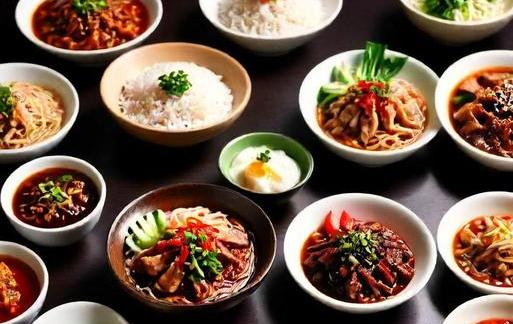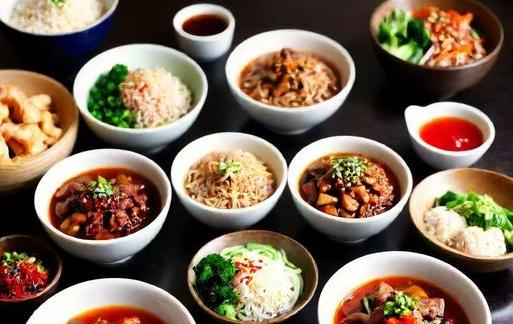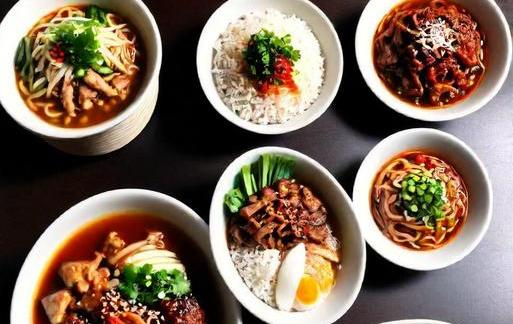- You are here:
- Home »
- Food
- » [REVEALED] Asian Foods That Start With X
[REVEALED] Asian Foods That Start With X
Note: This page contains affiliate links.
As an Amazon Associate, I earn from qualifying purchases when you click on the link, but you are not charged extra.
Asian cuisine is a treasure trove of diverse and flavorful dishes, each offering a unique blend of ingredients and culinary techniques. Exploring the vast expanse of Asian foods introduces us to a multitude of flavors, textures, and aromas that have delighted palates for centuries. In this gastronomic journey, we focus on a distinctive and often overlooked category: Asian foods that start with the letter “X”. While the selection may not be as extensive as other letters, there are indeed intriguing and delicious options waiting to be discovered.
Contents
List Of Asian Foods That Start With X

1. Xiao Long Bao
Xiao Long Bao, also known as soup dumplings, is a Chinese delicacy that originated in Shanghai. These dumplings are characterized by their delicate, thin skin and a rich, flavorful broth encapsulated within. The filling typically consists of minced pork, but variations with crab or other proteins are also popular. Xiao Long Bao is skillfully crafted, requiring precision to create the perfect balance between the wrapper, filling, and broth. Served with ginger slices and a soy-vinegar dipping sauce, these dumplings are a sensory delight.
2. Xinjiang Nang Bread
Xinjiang Nang Bread is a staple in the cuisine of the Xinjiang Uighur Autonomous Region in northwest China. This flatbread is unleavened and has a unique appearance with decorative imprints. It is traditionally baked in tandoor ovens, resulting in a crispy exterior and a soft, chewy interior. Often topped with sesame seeds or other grains, Xinjiang Nang Bread complements various dishes and is commonly enjoyed with lamb skewers, cumin-spiced dishes, or on its own with a cup of tea.
3. Xacuti
Xacuti is a flavorful curry hailing from the Indian state of Goa. This Goan curry is renowned for its intricate blend of spices, creating a rich and aromatic dish. The base often includes grated coconut, poppy seeds, and a mix of various spices such as cinnamon, cardamom, and cloves. Xacuti can be prepared with chicken, lamb, or prawns, and the result is a delectable curry that tantalizes the taste buds with its complexity of flavors. It is commonly served with rice or bread, making it a popular choice among food enthusiasts.
4. Xôi Xéo
Xôi Xéo is a Vietnamese sticky rice dish that stands out for its vibrant yellow color, derived from the addition of turmeric. This dish is a delightful blend of glutinous rice, mung beans, fried shallots, and shredded dried shrimp, creating a harmonious combination of textures and flavors. Often served with Vietnamese pork sausages (gio lua) and a side of pickled vegetables, Xôi Xéo is a beloved street food that showcases the culinary ingenuity of Vietnamese cuisine.
5. Xi’an Biang Biang Noodles
Xi’an Biang Biang Noodles originate from the Shaanxi province in China and are known for their wide, hand-pulled noodles. The name "Biang Biang" refers to the sound made during the preparation of these noodles, as the dough is forcefully slapped on the countertop. The resulting noodles are thick, satisfyingly chewy, and typically dressed with a savory sauce made from ingredients like chili oil, soy sauce, and garlic. Toppings may include minced meat, vegetables, or various condiments, making Xi’an Biang Biang Noodles a hearty and flavorful dish.
6. Xidoufen
Xidoufen, also known as Yunnan Crossing-the-Bridge Noodles, is a popular dish from the Yunnan province in China. This noodle soup features a variety of fresh ingredients, including thin slices of meat (usually chicken or pork), vegetables, and rice noodles. The components are served separately, and the hot broth is poured over the ingredients just before consumption, ensuring that each bite is warm and flavorful. Xidoufen is not only a culinary delight but also a cultural experience, reflecting the diversity and creativity of Yunnan cuisine.
7. XO Sauce
XO Sauce is a luxurious condiment that originated in Hong Kong and has become a staple in Cantonese cuisine. Despite its name, the sauce does not contain cognac (XO), but rather signifies an extra-special or high-quality blend. It is a rich and umami-packed concoction made from dried seafood, including scallops and shrimp, combined with garlic, chili peppers, and various savory ingredients. XO Sauce adds depth and complexity to a wide range of dishes, from stir-fries to seafood and even as a flavorful dip. Its versatility and bold flavors have earned it a revered place in Asian culinary traditions.
8. Xian Bing
Xian Bing, or Chinese pan-fried dumplings, are a popular street food enjoyed across China. These dumplings are distinguished by their crispy bottoms and pleated, doughy exteriors. The filling can vary, featuring a mix of vegetables, meat, and seasonings. Xian Bing are typically pan-fried until golden brown, creating a delightful contrast of textures. They are often served with a dipping sauce, such as a soy-based mixture, enhancing the overall experience of enjoying these savory parcels of goodness.
9. Xôi Lá Chuối
Xôi Lá Chuối is a Vietnamese dessert that translates to "Banana Leaf Sticky Rice." This sweet treat combines glutinous rice, mung beans, and coconut milk, all wrapped in banana leaves and steamed to perfection. The result is a sticky, fragrant, and slightly sweet dish that showcases the diverse use of rice in Vietnamese cuisine. Xôi Lá Chuối is often enjoyed as a dessert or snack, reflecting the cultural significance of sticky rice in Vietnamese culinary traditions.
10. Xuecai Rousi Mian
Xuecai Rousi Mian, or Snow Vegetable Meat Sauce Noodles, is a classic dish from the northeastern region of China. The noodles are served with a savory meat sauce made from minced pork and pickled Chinese cabbage, known as xuecai or "snow vegetable." The pickled cabbage adds a unique tangy and crunchy element to the dish, balancing the richness of the meat sauce. Xuecai Rousi Mian exemplifies the regional diversity within Chinese cuisine, offering a satisfying and comforting noodle dish that has stood the test of time.
As we explore the world of Asian foods that start with the letter "X", we unveil a diverse and intriguing array of culinary delights. From the delicate intricacies of Xiao Long Bao to the robust flavors of Xacuti, each dish reflects the rich tapestry of Asian gastronomy. These foods not only showcase the creativity of Asian chefs but also highlight the cultural significance and diversity present in each region. Whether you find yourself savoring the crispy Xinjiang Nang Bread or indulging in the comforting warmth of Xidoufen, the journey through these Asian foods provides a deeper understanding of the culinary traditions that have been passed down through generations. As you embark on your culinary exploration, remember that the world of Asian cuisine is vast and ever-evolving, offering a lifetime of discovery for those willing to savor the flavors of 'X' in the world of food.
Significance

Asian cuisine is a rich tapestry of flavors, textures, and culinary traditions that have captivated food enthusiasts worldwide. However, when it comes to identifying Asian foods that start with the letter “X”, the challenge may seem daunting. The scarcity of such examples makes each discovery a treasure.
The significance of Asian foods that start with ‘X’ lies not only in their rarity but also in the cultural diversity they represent. Asian cuisine is renowned for its wide array of ingredients, cooking techniques, and regional specialties. By identifying and understanding foods with names starting with “X”, we gain insights into lesser-known corners of Asian culinary traditions. Moreover, these culinary curiosities contribute to the broader narrative of global gastronomy, fostering appreciation for the diversity that makes each cuisine unique.
Category-Related

1. Xiao Long Bao
One of the most well-known Asian foods starting with ‘X’ is Xiao Long Bao. Hailing from China, this steamed dumpling is filled with hot, flavorful broth and minced pork. The delicate folds of the dumpling skin encapsulate the broth, creating a burst of savory goodness with each bite. Xiao Long Bao is often enjoyed with a side of black vinegar and ginger, enhancing the overall dining experience.
2. Xacuti
Originating from the Indian state of Goa, Xacuti is a fragrant and flavorful curry that often features chicken or lamb. What sets Xacuti apart is its unique blend of spices, including poppy seeds, white poppy seeds, dried red chilies, and grated coconut. The result is a rich and aromatic curry that showcases the diverse influences present in Goan cuisine, reflecting the region’s historical connections with Portuguese and Indian culinary traditions.
3. Xôi Xéo
In Vietnamese cuisine, Xôi Xéo is a sticky rice dish that stands out for its vibrant yellow color, derived from turmeric. The glutinous rice is steamed and topped with mung bean paste, fried onions, and sometimes shredded chicken or pork. Xôi Xéo represents the harmonious balance of textures and flavors commonly found in Vietnamese cuisine, where the interplay of sweet, savory, and crunchy elements is celebrated.
Common Themes
While Asian foods that start with ‘X’ may appear disparate, there are common themes that weave through these culinary delights.
1. Umami Sensation
Across different regions and cuisines, Asian foods are often characterized by the presence of umami – the savory, fifth taste. Whether it’s the rich broth inside Xiao Long Bao, the complex spice blend in Xacuti, or the interplay of flavors in Xôi Xéo, umami takes center stage, creating a deeply satisfying and memorable dining experience.
2. Cultural Fusion
Many Asian foods, including those starting with “X”, showcase the influence of cultural exchange. Xacuti, with its blend of Portuguese and Indian flavors, exemplifies the fusion that occurs when culinary traditions intertwine. This cultural amalgamation not only adds depth to the dish but also reflects the historical interconnectedness of diverse communities.
3. Artistry In Presentation
Asian culinary traditions often emphasize the artistry in food presentation. Xiao Long Bao, with its meticulously pleated dumpling skin, and Xôi Xéo, with its vibrant and visually appealing colors, exemplify the importance placed on aesthetics in Asian cuisine. Beyond taste, the visual appeal of these dishes adds another layer to the overall dining experience.
Interesting Facts
1. Xian Cai
While not a widely recognized dish, Xian Cai is an interesting inclusion in the realm of Asian foods starting with “X”. Hailing from China, Xian Cai refers to various pickled vegetables, showcasing the Chinese penchant for preserving and transforming fresh produce into flavorful accompaniments. The variety of vegetables used, such as mustard greens and radishes, highlights the regional diversity in pickling techniques across China.
2. Xinomavro Grapes
In exploring Asian foods starting with “X”, we encounter the unexpected inclusion of Xinomavro grapes. Native to Northern Greece, Xinomavro grapes find their way into Asian cuisine, particularly in regions where winemaking is a long-standing tradition. The grapes are not only used for wine production but also in culinary applications, adding a unique sweetness and acidity to certain dishes.
3. Xinjiang Cuisine
The cuisine of China’s Xinjiang region is a captivating blend of Central Asian, Turkish, and Chinese flavors. While not centered around a specific dish starting with “X”, the mention of Xinjiang cuisine broadens our understanding of the diverse culinary landscape within Asia. Lamb skewers, hand-pulled noodles, and hearty bread are staples in Xinjiang cuisine, showcasing the region’s nomadic and agricultural influences.
Conclusion
In the realm of Asian foods that start with “X”, we discover a fascinating tapestry of flavors, culinary techniques, and cultural influences. From the well-known Xiao Long Bao to the lesser-known Xian Cai and unexpected inclusions like Xinomavro grapes, each dish contributes to the richness of Asian gastronomy. The significance of these foods goes beyond their names; they serve as windows into the diverse histories, traditions, and palates that define the continent’s culinary landscape. As we celebrate the rarity of Asian foods starting with “X”, we also celebrate the vibrancy and dynamism that make Asian cuisine a perpetual source of culinary exploration and delight.


